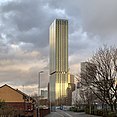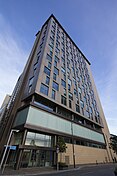
Chichester Cathedral, formally known as the Cathedral Church of the Holy Trinity, is the seat of the Anglican Bishop of Chichester. It is located in Chichester, in West Sussex, England. It was founded as a cathedral in 1075, when the seat of the bishop was moved from Selsey.

Cartmel Priory church serves as the parish church of Cartmel, Cumbria, England.

The Cathedral Church of the Holy Trinity,Saint Peter, Saint Paul and Saint Swithun, commonly known as Winchester Cathedral, is the cathedral of the city of Winchester, England, and is among the largest of its kind in Northern Europe. The cathedral is the seat of the Bishop of Winchester and is the mother church for the ancient Diocese of Winchester. It is run by a dean and chapter, under the Dean of Winchester.

The Cathedral of the Blessed Virgin Mary is a Church of England cathedral in the city of Truro, Cornwall. It was built between 1880 and 1910 to a Gothic Revival design by John Loughborough Pearson on the site of the parish church of St Mary. It is one of only three cathedrals in the United Kingdom featuring three spires.
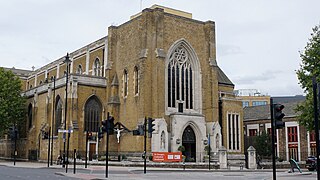
The Metropolitan Cathedral Church of St George, usually known as St George's Cathedral, Southwark, is the cathedral of the Roman Catholic Archdiocese of Southwark, south London, and is the seat of the Archbishop of Southwark.

Manchester Cathedral, formally the Cathedral and Collegiate Church of St Mary, St Denys and St George, in Manchester, England, is the mother church of the Anglican Diocese of Manchester, seat of the Bishop of Manchester and the city's parish church. It is on Victoria Street in Manchester city centre and is a grade I listed building.

The Cathedral Church and Minor Basilica of Saint Patrick is the cathedral church of the Roman Catholic Archdiocese of Melbourne in Victoria, Australia, and seat of its archbishop, currently Peter Comensoli.
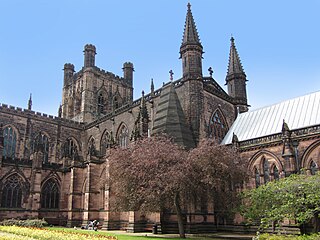
Chester Cathedral is a Church of England cathedral and the mother church of the Diocese of Chester. It is located in the city of Chester, Cheshire, England. The cathedral, formerly the abbey church of a Benedictine monastery dedicated to Saint Werburgh, is dedicated to Christ and the Blessed Virgin Mary. Since 1541, it has been the seat of the Bishop of Chester.

The Cathedral Church and Minor Basilica of the Immaculate Mother of God, Help of Christians is the cathedral church of the Roman Catholic Archdiocese of Sydney and the seat of the Archbishop of Sydney, currently Anthony Fisher OP. It is dedicated to the "Immaculate Mother of God, Help of Christians", Patroness of Australia and holds the title and dignity of a minor basilica, bestowed upon it by Pope Pius XI on 4 August 1932.
The Cathedral of the Good Shepherd is the oldest Roman Catholic church in Singapore, built in 1847. It is located in the Museum Planning Area within the Civic District.

The Metropolitan Cathedral Church and Basilica of Saint Chad is a Catholic cathedral in Birmingham, England. It is the mother church of the Archdiocese of Birmingham and is dedicated to Saint Chad of Mercia.

Saint Joseph Cathedral is located at 50 Franklin Street in downtown Buffalo, New York within the Joseph Ellicott Historic District, and is currently the cathedral church of the Roman Catholic Diocese of Buffalo.
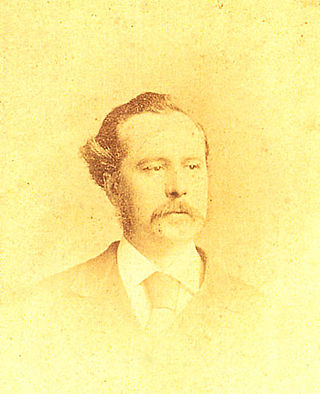
Edward Welby Pugin was an English architect, the eldest son of architect Augustus Welby Northmore Pugin and Louisa Barton and part of the Pugin & Pugin family of church architects. His father was an architect and designer of Neo-Gothic architecture, and after his death in 1852 Edward took up his successful practice. At the time of his own early death in 1875, Pugin had designed and completed more than one hundred Catholic churches.

The Cathedral of St Stephen is the heritage-listed cathedral church of the Roman Catholic Archdiocese of Brisbane and seat of its archbishop in Brisbane, Queensland, Australia. St Stephen's was only meant to serve as a temporary seat for the archbishop, and plans for a replacement were made with the Holy Name Cathedral, however the cathedral was never built.

The Cathedral Church of St Mary and St Thomas is a Roman Catholic cathedral in Northampton, England. It is the seat of the Bishop of Northampton and mother church of the Diocese of Northampton which covers the counties of Northamptonshire, Bedfordshire, Buckinghamshire and part of Berkshire north of the River Thames. The cathedral is situated in the north of the town, along the Barrack Road.

Leeds Cathedral, formally the Cathedral Church of St Anne, commonly known as Saint Anne's Cathedral, is the cathedral of the Roman Catholic Diocese of Leeds, and is the seat of the Roman Catholic Bishop of Leeds. It is in the city of Leeds, West Yorkshire, United Kingdom. The city of Leeds does not have a Church of England cathedral although it is in the Anglican Diocese of Leeds. The cathedrals of the diocese are in Ripon, Wakefield and Bradford. The city instead has a Minster which is similar to nearby Dewsbury Minster and Halifax Minster, all of which are parish churches.
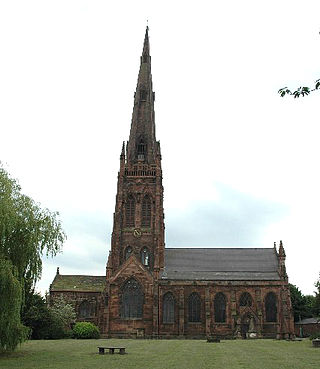
St Elphin's Church is the parish church of the town of Warrington, Cheshire, England. The church is recorded in the National Heritage List for England as a designated Grade II* listed building. It is an active Anglican parish church in the diocese of Liverpool, the archdeaconry of Warrington and the deanery of Warrington.
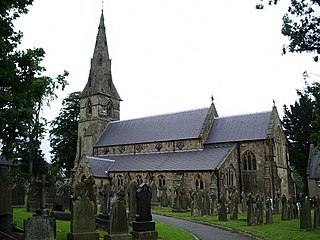
St John the Evangelist's Church is in Ribby Road, Kirkham, Lancashire, England. It is an active Roman Catholic parish church in the diocese of Lancaster. The church was designed by A. W. N. Pugin, and is recorded in the National Heritage List for England as a designated Grade II listed building.

The Church of St Mary of the Assumption is in Yorkshire Street, Burnley, Lancashire, England. It is an active Roman Catholic parish church in the diocese of Salford. The church is recorded in the National Heritage List for England as a designated Grade II listed building. It was built between 1846 and 1849 to replace a smaller chapel on a different site. The church was designed by Weightman and Hadfield in Decorated style, and a chapel was added to it in 1879.
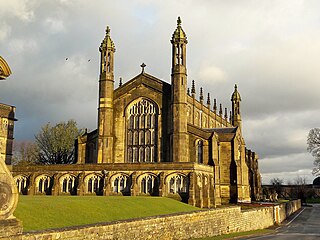
St Peter's Church is a Roman Catholic Parish Church in Stonyhurst. It is the parish church for Hurst Green, Lancashire and a chapel for Stonyhurst College. It was built from 1832 to 1835 and designed by Joseph John Scoles in the Gothic Revival style. It was founded by the Society of Jesus and has been served by Jesuit priests since. It is a Grade I listed building.
























